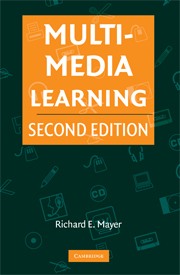Book contents
- Frontmatter
- Contents
- PREFACE
- SECTION I INTRODUCTION TO MULTIMEDIA LEARNING
- SECTION II PRINCIPLES FOR REDUCING EXTRANEOUS PROCESSING IN MULTIMEDIA LEARNING
- 4 Coherence Principle
- 5 Signaling Principle
- 6 Redundancy Principle
- 7 Spatial Contiguity Principle
- 8 Temporal Contiguity Principle
- SECTION III Principles for Managing Essential Processing in Multimedia Learning
- SECTION IV PRINCIPLES FOR FOSTERING GENERATIVE PROCESSING IN MULTIMEDIA LEARNING
- SECTION V CONCLUSION
- REFERENCES
- AUTHOR INDEX
- SUBJECT INDEX
- References
4 - Coherence Principle
- Frontmatter
- Contents
- PREFACE
- SECTION I INTRODUCTION TO MULTIMEDIA LEARNING
- SECTION II PRINCIPLES FOR REDUCING EXTRANEOUS PROCESSING IN MULTIMEDIA LEARNING
- 4 Coherence Principle
- 5 Signaling Principle
- 6 Redundancy Principle
- 7 Spatial Contiguity Principle
- 8 Temporal Contiguity Principle
- SECTION III Principles for Managing Essential Processing in Multimedia Learning
- SECTION IV PRINCIPLES FOR FOSTERING GENERATIVE PROCESSING IN MULTIMEDIA LEARNING
- SECTION V CONCLUSION
- REFERENCES
- AUTHOR INDEX
- SUBJECT INDEX
- References
Summary
Coherence Principle: People learn better when extraneous material is excluded rather than included. The coherence principle can be broken into three complementary versions: (1) Learning is improved when interesting but irrelevant words and pictures are excluded from a multimedia presentation; (2) learning is improved when interesting but irrelevant sounds and music are excluded from a multimedia presentation; and (3) learning is improved when unneeded words and symbols are eliminated from a multimedia presentation. Each version of the coherence principle is addressed in turn in this chapter.
Example: A learner receives a concise narrated animation (concise group) or the same lesson along with interesting but irrelevant video clips or photos, interesting but irrelevant facts or stories, background music, or specific details (expanded group).
Theoretical Rationale: Extraneous material competes for cognitive resources in working memory and can divert attention from the important material, disrupt the process of organizing the material, and prime the learner to integrate the material with an inappropriate theme.
Empirical Rationale: In thirteen out of fourteen tests, learners who received concise multimedia presentations performed better on tests of transfer than did learners who received multimedia messages that contained extraneous material. The median effect size is d = 0.97.
Boundary Conditions: The coherence principle may be particularly important for learners with low working-memory capacity or low domain knowledge.
Information
- Type
- Chapter
- Information
- Multimedia Learning , pp. 89 - 107Publisher: Cambridge University PressPrint publication year: 2009
References
Accessibility standard: Unknown
Why this information is here
This section outlines the accessibility features of this content - including support for screen readers, full keyboard navigation and high-contrast display options. This may not be relevant for you.Accessibility Information
- 3
- Cited by
